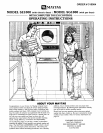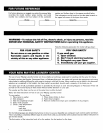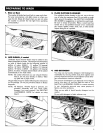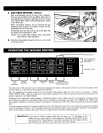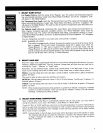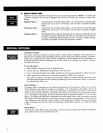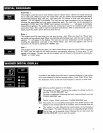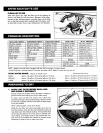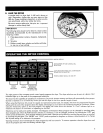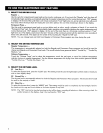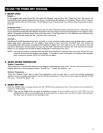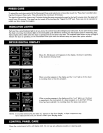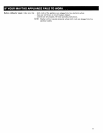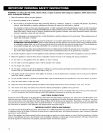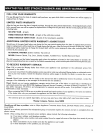
WARNING-To reduce the risk of fire, electric shock, or injury to persons when using your appliance, follow basic precauo
tions, including the following:
1. Read all instructions before using the appliance.
2. To avoid the possibility of fire or explosion:
a. Do not wash or dry articles that have been previously cleaned in, washed in, soaked in, or spotted with gasoline, dry-cleaning
solvents, other flammable or explosive substances as they give off vapors that could ignite or explode.
Any material on which you have used a cleaning solvent, or which is saturated with flammable liquids or solids, should not be placed
in the appliance until all traces of these flammable liquids or solids and their fumes have been removed. There are many highly flam-
mable items used in homes, such as: acetone, denatured alcohol, gasoline, kerosene, some liquid household cleaners, some spot
removers, turpentine, waxes and wax removers.
b. Do not add gasoline, dry-cleaning solvents, or other flammable or explosive substances to the wash water. These substances give off
vapors that could ignite or explode.
c. Under certain conditions, hydrogen gas may be produced in a hot water system that has not been used for 2 weeks or more.
HYDROGEN GAS IS E3_PLOSIVE. If the hot water system has not been used for such a period, before using a washing machine
or combination washer-dryer, turn on all hot water faucets and let the water flow from each for several minutes. This will release any
accumulated hydrogen gas. As the gas is flammable, do not smoke or use an open flame during this time.
d. Items containing foam rubber (may be labeled latex foam) or similarly textured rubber like materials must not be dried on a heat set-
ting. Foam rubber materials when heated, can under certain circumstances produce fire by spontaneous combustion.
3. Do not allow children to play on or in the appliance. Close supervision of children is necessary when the appliance is used near children.
4. Before the appliance is removed from service or discarded, remove the door to the washing and drying compartment.
5. Do not reach in to the appliance if the tub, agitator, or drum is moving.
6. Do not install or store this appliance where it will be exposed to the weather.
7. Do not tamper with controls.
8. Do not repair or replace any part of the appliance or attempt any servicing unless specifically recommended in published user-repair in-
structions that you understand and have the skills to carry out.
9. The agitator should not be removed. If the agitator is removed, it must be pushed down completely and the locking screw tightened
before the washer is operated.
10 Do not use fabric softeners or products to eliminate static unless recommended by the manufacturer of the fabric softener or product.
11. Clean lint screen before or after each load.
12. Keep area around the exhaust opening and adjacent surrounding areas free from the accumulation of lint, dust. and dirt.
13. The interior of the dryer and exhaust duct should be cleaned periodically by qualified service personnel.
14. This appliance must be properly grounded Never plug appliance electric cord into a receptacle which has not been grounded adequate-
ly and in accordance with local and national codes. See installation instructions for grounding this appliance_
SAVE THESE INSTRUCTIONS
Appliances with the (_ symbol on the data plate have been listed with Underwriters' Laboratories, Inc. Those with a CSA Monogram on the
data plate have been certified by the CSA Testing Laboratories as complying with Canadian Standards Association requirements. Gas dryers
with an AGA symbol on the data plate have been design certified with the American Gas Association. Nevertheless, as with any equipment
using electricity and having moving parts, there are potential hazards. To use this appliance safely, the operator should become familiar with
the instructions for operation of the Appliance and always exercise care while using it.
IMPORTANT SAFETY NOTICE AND WARNING
The California Safe Drinking Water and Toxic Enforcement Act of 1986 (Proposition 65) requires the Governor of California to publish a list
of substances known to the State of California to cause cancer or reproductive harm, and requires businesses to warn customers of potential
exposures to such substances.
Users of this appliance are hereby warned that the burning of gas can result in Iowqevel exposure to some of the listed substances, including
benzene, formaldehyde and soot, due primarily to the incomplete combustion of natural gas or liquid petroleum (LP) fuels. Exhaust ducts
should be kept free of obstructions and properly exhausted dryers will minimize exposure.
13



